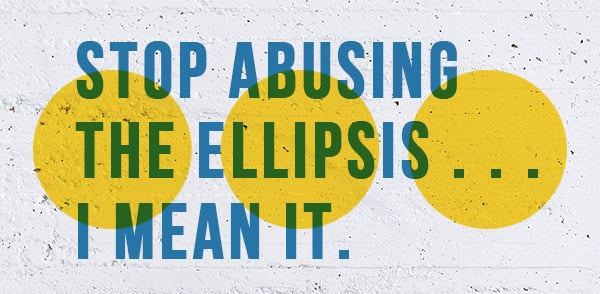Writing with AI - Learn more
Writing with AI - Learn more


An ellipsis (ellipses is the plural) is the … you see all over social media. It has its place for sure, but it’s also wildly overused and, quite frankly, abused.
Here’s my “theory” on why - you know the three dots you see when the person you are messaging is typing their message?

These signify the other person is writing AND thinking about what they are writing. So, we’ve started to use this more and more as a way of showing a pause to think.
Yes, my theory is that social media has caused us to overuse ellipses just like it has caused us to overuse commas. Both of these have become sort of all-purpose punctuation marks on social media! That’s fine in an informal setting or a text to a friend, but it will convey a lack of professionalism in a message to your boss or in an email.
You can ONLY use it to show missing words in an exact quote. Here’s an example:
“Two roads diverged in a yellow wood, and sorry I could not travel both ... I took the one less traveled by, and that has made all the difference.” (Robert Frost, The Road Not Taken)
The ellipsis signifies that there is content missing. In this case, it’s nearly the entirety of the poem. But, in many cases, it’s a less significant part of a quote. You’ll note this use in the news a lot.
Style guides disagree on the formatting of the ellipsis. The notification that many social media sites use when someone is typing that adds spaces between the periods is not the preferred format for an ellipsis in business writing. The 2019 AP Stylebook, which is the dominant style guide for business writing and web writing, recommends that an ellipsis should be treated as a three-letter word. Format an ellipsis as three periods next to each other with a space before the first period and after the last period.
Full quotation: "Today, after hours of careful thought, we approved the bill."
With an ellipsis: "Today … we approved the bill."
I know that you are likely thinking, “Well, I never use quotes in my business writing! Do you mean I should never use ellipses?”
Yes, that’s exactly what I mean. The only correct way to use an ellipsis in business writing is to show missing text in a quote.
Ellipses are ok in social media or informal text messages but should not be used in business writing for anything other than indicating missing words in a direct quote. Why? All writing is context and audience-dependent. Business readers need and expect clarity, precision, and correct grammar.
Raise professionalism in your business writing to ensure that you present yourself as competent, confident, and precise.
Image Source: Grammarly
